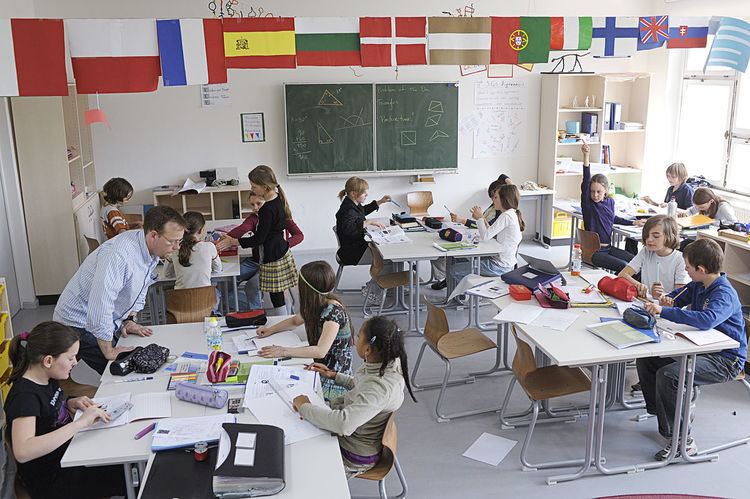 | ||
Activity-based learning or ABL describes a range of pedagogical approaches to teaching. Its core premises include the requirement that learning should be based on doing some hands-on experiments and activities. The idea of activity-based learning is rooted in the common notion that children are active learners rather than passive recipients of information. If child is provided the opportunity to explore by their own and provided an optimum learning environment then the learning becomes joyful and long-lasting.
Contents
History of activity-based learning
Activity-based learning started sometime in 1944 around World War II when a British man David Horsburgh came to India and finally decided to settle down there. He was an innovative thinker and charismatic leader. He started teaching in Rishi Valley School. He joined the British Council and worked in Chennai and Bangalore for many years. After his voluntary retirement, he located a 7-acre (28,000 m2) site in Kolar District and opened his school, Neel Bagh. Neel Bagh was based on an innovative idea of Horsburgh and known for its creative methods in teaching well-planned learning materials. With his wife Doreen and his son Nicholas, Horsburgh developed a diverse curriculum, which included music, carpentry, sewing, masonry, gardening, as well as the usual school subjects, English, mathematics, Sanskrit, and Telugu. These pedagogic materials were systematically planned, with sketches and drawings and an occasional touch of humour. Later Horsburgh created a magnificent library in Neel Baugh that was accessible to teachers and students. This initiative of Horsburgh was later proved to be one of the pioneer and milestones in ABL. In modern time ABL is the method of education followed in the Corporation schools of Chennai, from 2003, as an effort to provide special schools for children who had been freed from bonded labour.
States and Organizations initiative on activity-based learning
The ABL in its contemporary form was first undertaken by the Chennai Corporation in 13 schools on a trial basis in 2003, has been adopted by all the 270 primary schools in the district. First designed and tested by the Rishi Valley School in Andhra Pradesh in the '90s, the Activity-Based Learning system has been successfully implemented in several Indian states and union territory, including Karnataka, Kerala, Uttar Pradesh, Gujarat, Madhya Pradesh, Haryana. Maharashtra, Chandigarh. In Tamil Nadu, UNICEF supported the Chennai Corporation to introduce the ABL methods in the Government schools. There are many organizations which cultivate and follow the principles of activity-based learning. Digantar Siksha evam Khelkud Samiti in Rajasthan, Sumavanam Village School in Andhra Pradesh, Walden's Path in Telangana and Vikasana School in Karnataka are the places which were established on the principles of activity-based learning.
Philosophy
The philosophy of ABL finds its antecedents in the common notion that learning can be done best when it is initiated by the surrounding environment and motivated by providing optimum opportunities to learn. A fearless and freedom to express environment always adds to best learning outcomes.
Impact on India
Under Activity Based learning education main focus is on child or we can say that it is one of child centered approach. It develops self-learning skill among the learners and allows a child to study according to his or her skill . Activities here can be in the form of songs, Drawings,Rhymes,Role play to teach a letter or a word, solve mathematical problems, form a sentence, understand social science or even concept of science. The learner takes report Card only after completing all the steps in a subject. If a child is absent even a single day he starts from where he left unlike in the old system and the child had to do self learning of the missed portions.
The key feature of the Activity Based Learning (ABL) method is that it uses child-friendly educational aids to foster self-learning and allows a child to study according to his or her aptitude and skill. ABL serves as one model of child-centered, child-friendly education, which is the mandate of the Right of Children to Free and Compulsory Education Act (RTE) Act in India.
The Sarva Shiksha Abhiyan Scheme by Government has introduced many initiative and creative methods to bring about changes in teaching method for both- Teacher as well as learners. In state of Tamil Nadu, the elementary schools have taken initiative to use methodology called Activity Based Learning through Sarva Shiksha Abhiyan.
Characteristics of activity-based learning
The key feature of the ABL method is that it uses child-friendly educational aids to foster self-learning and allows a child to study according to his/her aptitude and skill. Under the system, the curriculum is divided into small units, each a group of Self Learning Materials (SLM) comprising attractively designed study cards for English, Tamil, maths, science and Social Science. When a child finishes a group of cards, he completes one "milestone". Activities in each milestone include games, rhymes, drawing, and songs to teach a letter or a word, form a sentence, do maths and science, or understand a concept. The child takes up an Exam Card only after completing all the milestones in a subject. On a common chart, the milestones are arranged in the form of a ladder and the child knows exactly which milestone he completed in the last lesson. This is a child-friendly way to evaluate and reinforce learning. If a child is absent one day, he/she continues from where he/she left unlike in the old system where the children had to learn on their own what they missed out on.
